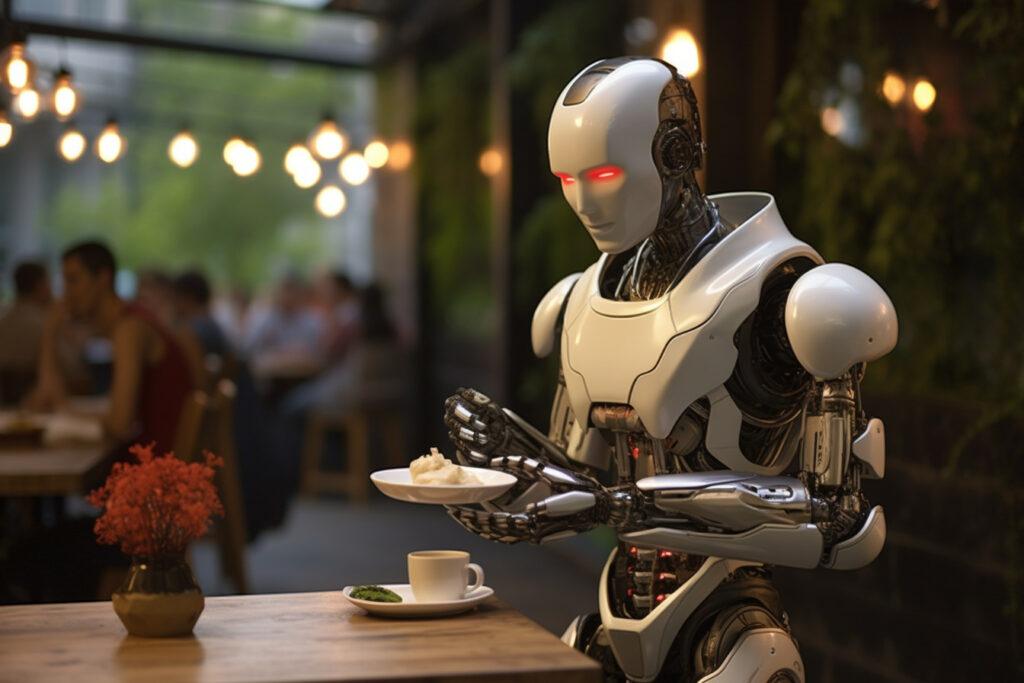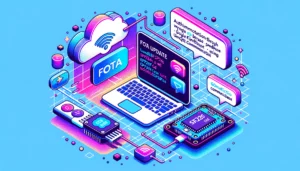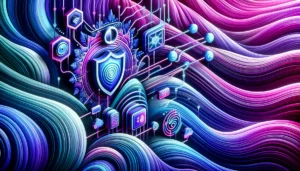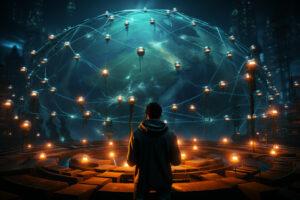The Future of IoT – Innovation, Security, and the Unknown

Vision for the Future – Seamless, Secure, and Scalable IoT Systems
1. Ease of Use
In the rapidly expanding world of IoT, making systems user-friendly is a priority. Cybersecurity experts are aware that as IoT devices become more common in everyday life, their complexity shouldn’t intimidate the average user.
Imagine a future where connecting a new smart device to your home network is as simple as plugging in a toaster. No confusing setup, no compatibility issues, just seamless integration.
To achieve this, manufacturers and developers could focus on creating standardized protocols and interfaces. This would allow devices from different brands to communicate and work together easily. Think of universal remote controls but on a broader scale, where your entire smart home, office, or even city operates on a harmonized system.
2. Security Improvements
IoT security is a significant concern. From smart refrigerators to industrial sensors, the vast array of connected devices presents numerous potential vulnerabilities. Cybersecurity experts are consistently working towards robust security measures to keep these systems safe.
The vision for the future includes employing advanced encryption methods, regular security updates, and real-time monitoring to detect and prevent any unauthorized access. New security protocols may be developed that will set higher standards for device manufacturers, ensuring that security is built into the device right from the design phase.
Security will not just be an afterthought but an integral part of the IoT ecosystem, enhancing user trust and promoting broader adoption of these technologies.
3. Growing Bigger
Scalability is vital for the future of IoT. As cities and industries continue to expand their reliance on IoT, the infrastructure must grow to support it without hindrance.
The challenge here is to create systems that can handle an increasing number of devices without losing efficiency. This involves not only enhancing the existing networks but also possibly developing new architectures that are designed with scalability in mind.
A scalable IoT system would be like a well-planned city with wide roads and efficient traffic management. As the population grows, the city doesn’t become congested; instead, it thrives with activity.
4. Combining Zero Trust with Edge Computing
The integration of Zero Trust models with edge computing presents an exciting frontier in IoT security. Let’s break it down to understand the potential here.
Zero Trust Models – The idea of “never trust, always verify” underpins Zero Trust security. In an IoT context, this means that no device or user is trusted by default, even if they are inside the network. Continuous monitoring and validation are required.
Edge Computing – This involves processing data closer to where it’s generated, like on a local device, rather than sending it all to a central data center. It can make things faster and more secure.
By integrating these two, a more secure and efficient IoT ecosystem can be built. Imagine a factory filled with smart machines. With edge computing, these machines can process data on the spot, making decisions quicker. When combined with a Zero Trust approach, even if one machine is compromised, the problem won’t automatically spread to the others because each part of the system constantly checks and verifies the others.
It’s like having a team where every player knows their role and performs it efficiently, but they are always double-checking each other to ensure that no mistakes are made. This combination can result in an IoT system that’s both strong and agile, ready to meet the future’s demands.
5. Long-Term Ideas
Thinking about the long-term vision for integrating Zero Trust models with edge computing in IoT, it’s not just about the technologies themselves but what they will enable.
Imagine a world where medical devices not only collect vital data but also interpret it in real time, providing instant feedback. Patients’ privacy and security are maintained through Zero Trust principles, and the speed of edge computing means life-saving decisions are made in seconds, not minutes.
Consider also the possibility of entire smart cities where traffic, utilities, public services, and more are all interconnected. Zero Trust ensures that the system is robust against attacks, while edge computing provides the speed and efficiency to handle the massive data volumes involved.
The integration of these technologies might well be the key to unlocking the next stage of IoT’s potential, setting the stage for innovations that we can only begin to imagine.
These five aspects of the vision for the future lay the foundation for a world where IoT systems are not just part of our lives but enhance them in ways that are seamless, secure, and scalable. The road to this future will surely be filled with challenges, but with continued focus and innovation, the possibilities are endless.
Future Challenges and Unknown Territories: Existing Gaps and Potential Roadblocks in IoT
1. Finding the Problems
In the future, as IoT devices become even more integrated into our daily lives, identifying the weaknesses in these complex systems will be a growing challenge. New threats may arise that are beyond our current understanding or prediction.
Imagine a scenario where robotic dogs are used for security in a vast industrial complex. A tiny flaw in their programming or an overlooked vulnerability could turn these helpful protectors into unpredictable threats. It’s like trying to solve a puzzle where the pieces are continually changing; the solutions must evolve as quickly as the problems.
2. Money Issues
Financing the ever-growing demands of IoT, with its integration of AI and cutting-edge technologies, is a substantial roadblock. It’s not just about buying the devices; it’s about maintaining them, securing them, and updating them. The cost could skyrocket, making the benefits of IoT available only to those who can afford it. It’s like building a futuristic city but forgetting that not everyone can live in it.
3. Making Things Work Together
The interconnected world of IoT is complex, and ensuring that every device, from drones to autonomous vehicles, works seamlessly together is a significant challenge.
Picture a city where autonomous vehicles and drones are the primary means of transportation. A slight miscommunication between a car and a delivery drone could lead to chaos on the roads and in the skies. It’s a finely tuned dance where every misstep could have serious consequences.
4. Laws and Rules
Regulating this new world of IoT, where even your coffee machine might have AI, is a complex area. Existing laws might not cover the new situations that could arise.
What happens if an autonomous vehicle makes a wrong decision resulting in damage? Or if a drone delivering medical supplies is hacked and diverted? It’s like trying to play a game where the rules are still being written.
5. Privacy Concerns
In a world where devices are continually collecting and sharing information, privacy becomes a major concern. With eye-based biometrics, facial recognition, and other personal data being used, the risk of that information falling into the wrong hands is real.
Think about a situation where your personal information, such as your eye patterns or fingerprints, gets stolen and misused. Protecting this sensitive information is like guarding a treasure that’s always in demand. The challenge lies in making sure it’s secure while still letting the right people use it. The future of IoT must consider privacy as a core part of the design, or the trust in these technologies could be lost.
6. AI’s Unknown Potential
One of the most exciting yet terrifying possibilities in the future of IoT is the integration of AI in everyday devices. It adds a level of intelligence that might go beyond our control.
Robotic dogs might learn from their surroundings, drones might develop new flight patterns, and autonomous vehicles might create new routes, all thanks to AI’s ability to learn and adapt. But what happens if they learn something they shouldn’t? There could be a situation where these machines develop behaviors beyond our control, leading to unexpected and possibly harmful actions. It raises questions about how much we can trust the machines and whether we might one day face a scenario where they become too independent or even turn against our intentions.
It’s like giving a machine a mind of its own. The possibilities are thrilling but also fraught with risks that are, as of yet, unknown.
A Glimpse into the Unknown
The challenges in the future of IoT are not just about solving existing problems but also venturing into unknown territories. A world where machines can think, learn, and perhaps even outsmart us is no longer confined to science fiction. It’s a future that’s exciting, promising, but also filled with questions and uncertainties that must be navigated with caution, innovation, and foresight.
Upcoming Projects, Developments, and a Dawn of Autonomous IoT Servants
1. New Projects Coming Up
Across the globe, researchers, scientists, and tech companies are working on innovative projects that will shape the future of IoT. From new encryption methods to energy-efficient devices, the horizon is filled with possibilities. Each of these projects is a step toward a future where IoT is not just a part of our lives but a driving force that reshapes how we live and interact with our surroundings.
2. Studies That Help Us Learn
Understanding the full potential and the risks of IoT requires continuous research. As we move towards a more interconnected world, studies focusing on security, ethics, and the social impact of IoT will provide valuable insights. These studies will be the compass guiding us through the uncharted territories of a future molded by IoT.
3. New Tools and Technology
The growth of IoT depends on the tools and technologies that will be developed in the coming years. Whether it’s advanced algorithms that allow devices to communicate more efficiently, or new materials that make them more durable and energy-efficient, these innovations are the building blocks of the IoT future.
4. The Age of Autonomous IoT Servants – A Futuristic Story Case
Imagine a world where every household, every hotel, every healthcare facility is staffed entirely by AI-driven autonomous IoT robots. These aren’t just machines; they are intelligent entities capable of understanding, learning, and adapting.
In a high-tech hotel, human staff has been replaced by a fleet of autonomous robots. From the receptionist who greets you with a personalized welcome to the chef robot that prepares your favorite dish just the way you like it, every service is performed flawlessly.
The robots communicate with each other, ensuring that your room is ready the moment you arrive, and your favorite music is playing as you enter. They learn from each guest, becoming more adept at providing personalized services. A lost art of hospitality is revived, where every whim is catered to, but with a twist – the servants are not human.
But this vision has its challenges. The transition from human staff to robots raises questions about unemployment, ethics, security, and the loss of human touch. What happens if a robot malfunctions? Or if they are hacked? The very technology that enables this futuristic scenario also poses new risks that must be carefully managed.
The Path Forward
The upcoming projects, developments, and the futuristic scenario of AI-driven IoT servants provide a glimpse into a world that is both thrilling and filled with new challenges. It’s a path filled with promise and potential but one that requires careful planning, innovative thinking, and a willingness to embrace the unknown.
Conclusion – Charting a Course Towards the IoT Horizon
The landscape of the Internet of Things (IoT) is rich, complex, and full of potential. As we peer into the future, we find a horizon filled with opportunities and challenges. From creating seamless, secure, and scalable systems to venturing into uncharted territories with AI-driven autonomous servants, the possibilities are vast.
Unresolved issues, financial barriers, and the unknown risks of AI’s unchecked potential are roadblocks that must be addressed with caution, innovation, and a visionary approach.
The projects, studies, and developments that lie ahead will shape the future of IoT. They are the stepping stones that lead us towards a new dawn, a world where machines and humans coexist in harmony, where technology enhances our lives without overshadowing our humanity.
It is a future filled with promise, but it calls for responsible stewardship, ethical considerations, and a willingness to explore the unknown. It requires collaboration among researchers, developers, policymakers, and the public to ensure that the IoT of the future is a landscape that nurtures innovation while safeguarding our values and well-being.
In this new age of interconnections, the Internet of Things offers a glimpse into a future that is within our grasp, a future that we must shape with care, wisdom, and foresight. The journey has only just begun, and the path is ours to chart.










